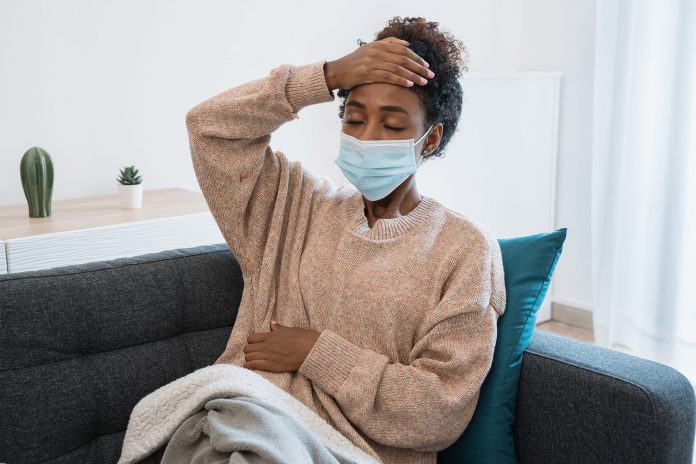Coronavirus is still infecting people across the globe, with most who develop symptoms exhibiting mild illness. According to the Centers for Disease Control and Prevention, most folks with a mild case of COVID-19 can recover at home.
Though some patients require inpatient care for their COVID-19 infection, most do not and are able to safely care for themselves at home, experts say. The key is understanding the symptoms and how to monitor them to manage your care safely.
This is how to treat yourself at home if you have mild coronavirus:
- Know the symptoms. The majority of patients will have a fever, and temperatures can soar to between 102 and 104 degrees. Many people will also have cough, sore throat, congestion, shortness of breath, muscle aches, severe fatigue, nausea, diarrhea, and an altered sense of taste and smell. Older patients or people with compromised immune systems can experience more atypical symptoms; sometimes fatigue and weakness are the only signs. Symptoms and duration can vary widely, lasting days for some and weeks for others. Sometimes patients get better at first, but then worsen dangerously in the second week. Maintain vigilance, especially if you have respiratory symptoms, like shortness of breath, or chest pain.
- Stay in touch with your medical team. Call your doctor as soon as COVID-19 symptoms start so he or she can monitor you. This is crucial if you have a higher risk of complications, particularly if you’re older than 60, or have underlying conditions such as obesity, chronic lung disease, diabetes, or heart disease. If you don’t have a primary care physician, establish a relationship with a doctor, especially one who has telemedicine capability. If you have a specialist for a condition such as cancer, let them know you have COVID-19 symptoms.
- Rest and drink fluids. Get plenty of rest and stay well hydrated. Fever and diarrhea can lead to dehydration, which can make you feel worse. Broth soups, tea with honey and fruit juice are also good choices. If your mouth feels dry, you’re lightheaded when you stand, and if your urine output declines (less than every four to five hours), those are signs of dehydration.
- Monitor your health. Keep a detailed list of your symptoms, and contact your doctor if you feel like you’re getting worse. Take your temperature at least twice a day and pay attention to your breathing, especially if you feel short of breath when resting or with minimal activity. COVID-19 is primarily a respiratory condition, and people who become severely ill need oxygen or a ventilator. If you have a pulse oximeter, a device that clips to your fingertip to measure your blood oxygen level, use it. (You can purchase one for less than $40 at your local drug store.) If your oxygen level falls below 95 percent, talk to your doctor. If it falls below 90 percent, call 911. If you are having trouble breathing, persistent pain or chest pressure, confusion, an inability to stay awake, or bluish lips or face, seek emergency medical care immediately.
- Treat your symptoms. There is no specific treatment for COVID-19, but you can take steps to support your recovery. High or persistent fevers are dangerous because they make dehydration worse, cloud your thinking, and increase oxygen demands of your vital organs. That’s why treating your fever is so important. Take 500 milligrams to 1,000 milligrams of an over-the-counter fever reducer such as acetaminophen every six to eight hours to keep your temperature less than 100 degrees. Steamy hot showers can ease sore throat and congestion. Over-the-counter antidiarrheal medications can help, especially if stools are watery and episodes are up to eight to 10 a day. You might need an inhaler to ease chest tightness or wheezing associated with COVID-19 infection. Consult your physician plan your treatment.
- Ask for help. Get household members to grocery shop, fill your prescriptions and help with your other needs. If you live alone, reach out to a friend or family member to check in with you. Ask someone who lives nearby if they leave groceries and necessities at your door. Use a delivery service to stock up on nonperishable food, medications and household supplies. Create an emergency contact list of family, friends, neighbors and your medical team.
- Protect others. Avoid spreading the virus. Stay home except for medical visits, and self-isolate in one room as much as possible, including for meals. Use a separate bathroom from your housemates, if available; if not, clean and disinfect frequently touched surfaces after you use them. Avoid older or frail relatives with medical conditions. Wear a mask if you are around others, and stay 6 feet apart. Open the windows of shared spaces and use a fan for good air flow. Follow the CDC’s recommendations for how to safely do care for someone with COVID-19. Do not share cups, plates, utensils, towels or bedding, and clean surfaces such as telephones, doorknobs and handles daily. Everyone in the house should wash their hands frequently for at least 20 seconds with soap and water or use a hand sanitizer with at least 70 percent alcohol for 30 seconds.
- Ease back to normal. Recovery can range from a few days to more than two weeks for severe cases. Even when you’re feeling well, you could still be contagious, so check with your doctor before leaving your sick room and home. The CDC says you can be with others after you’ve been fever-free for three full days without using a fever-reducing medicine, your other symptoms have improved and at least 10 days have passed since your symptoms first appeared. Even mild coronavirus can be debilitating. Be gentle with yourself.






